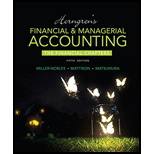
Analyzing and journalizing bond transactions
On January 1, 2016, Teacher Credit Union (TCU) issued 8%, 20-year bonds payable with Face value of $400,000. The bonds pay interest on June 3 0 and December 31.
Requirements
1. If the market interest rate is 6% when TCU issues its bonds, will the
2. If the market interest rate is 9% when TCU issues its bonds, will the bonds be priced at Face value, at a premium, or at a discount? Explain.
3. The issue price of the bonds is 96. Journalize the following bond transactions:
a. Issuance of the bonds on January 1, 2016.
b. Payment of interest and amortization on June 30, 2016.
c. Payment of interest and amortization on December 31, 2016.
d. Retirement of the bond at maturity on December 31, 2035.
Want to see the full answer?
Check out a sample textbook solution
Chapter 12 Solutions
Horngren's Financial & Managerial Accounting, The Financial Chapters Plus MyAccountingLab with Pearson eText -- Access Card Package (5th Edition)
- Lao Enterprises is preparing its direct labor budget for June. Projections for the month are that 18,200 units are to be produced and that direct labor time is 2.5 hours per unit. If the labor cost per hour is $14, what is the total budgeted direct labor cost for June?arrow_forwardPlease provide answer this financial accounting question answer do fastarrow_forwardNonearrow_forward
- Principles of Accounting Volume 1AccountingISBN:9781947172685Author:OpenStaxPublisher:OpenStax College
 Financial Accounting: The Impact on Decision Make...AccountingISBN:9781305654174Author:Gary A. Porter, Curtis L. NortonPublisher:Cengage Learning
Financial Accounting: The Impact on Decision Make...AccountingISBN:9781305654174Author:Gary A. Porter, Curtis L. NortonPublisher:Cengage Learning Financial AccountingAccountingISBN:9781305088436Author:Carl Warren, Jim Reeve, Jonathan DuchacPublisher:Cengage Learning
Financial AccountingAccountingISBN:9781305088436Author:Carl Warren, Jim Reeve, Jonathan DuchacPublisher:Cengage Learning  Cornerstones of Financial AccountingAccountingISBN:9781337690881Author:Jay Rich, Jeff JonesPublisher:Cengage Learning
Cornerstones of Financial AccountingAccountingISBN:9781337690881Author:Jay Rich, Jeff JonesPublisher:Cengage Learning Excel Applications for Accounting PrinciplesAccountingISBN:9781111581565Author:Gaylord N. SmithPublisher:Cengage Learning
Excel Applications for Accounting PrinciplesAccountingISBN:9781111581565Author:Gaylord N. SmithPublisher:Cengage Learning EBK CONTEMPORARY FINANCIAL MANAGEMENTFinanceISBN:9781337514835Author:MOYERPublisher:CENGAGE LEARNING - CONSIGNMENT
EBK CONTEMPORARY FINANCIAL MANAGEMENTFinanceISBN:9781337514835Author:MOYERPublisher:CENGAGE LEARNING - CONSIGNMENT





